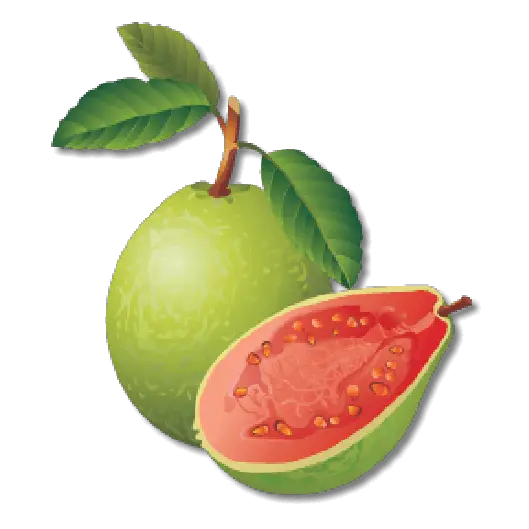In this guide I’m going to take you through to the different types of guava plant and uses.
Summary: guava gave numerous uses both as source of food and medicines. Guava contains high amount of fiber and vitamins. Guava is among the most nutritious fruits. Common types of guava include pineapple guava, lemon guava, and common guava.
For details about the uses and types of guava, follow along with this handy article.
General Overview
The guava tree is a small tree of not more than 15m tall, which is belong to the Myrtaceae family. It is one of the dominant fruits in the tropical and subtropical forests. It is one of the widely cultivated fruit in those areas because of the tree’s edible fruit and medicinal leaves. However, some of the wild types are not edible.
People are familiar with the term guava. But, are all guavas the same?
When you take a look at guava, you may come to the conclusion that there is only one guava but only have different colors, aroma, and taste.
However, in botany that is not the case. Guava is only one type out of the so many types of guavas.
Learn more about the Botany of guava plant here.
In this guide, we are going to teach you on how to identify the different guavas base on types and varieties.
How many types of guava trees are there?
There are roughly more than 100 different types of species of guavas with different varieties that are grown and eaten in our daily lives.
For the sake of this guide, we are going to discuss a few of them here. Learn more from our guide to wild and cultivated species of guava.
Below are some of the common wild and cultivated types of guava:
- Strawberry guava
- Common guava
- Pineapple guava
- Wild guava
- Guinea Guava
Strawberry guava

Strawberry guava is also known as lemon guava. Other common names include cattley guava as it is called in the United States, guayaba in Japonesa, and Waiawi in Hawaii.
Strawberry guava is a common sub-tropical tree, which is scientifically known as Psidium cattleianum. It can also be called as P. littorale.
Description
- It is a shrub woody tree
- The fruit is small and round of not more than 3 to 5cm in diameter
- The color of skin is red, and sometimes lime yellow
- The fruit skin is initially green and later turn to red or yellow when fully ripe
- The inner fleshy part is like a jelly that is perforated with seeds
- It posses fragrant aroma
- It tastes like a lime flavor
Uses of strawberry guava
This type of guava tree is high in vitamins like vitamins A and B. Strawberry guava also contains folate and essential minerals such as potassium.
Because of these nutrients content, strawberry guava plant is frequently used in the management of heart diseases and stomach problems.
It is also a good source of energy, which can either be eaten fresh or cooked. It is also widely used in the production of beverages, smoothies, frozen desserts, dressings, marinades, and souces.
The pleasant aroma of strawberry guava is used to hide the unpleasant smell of chicken and fish in some areas of tropical American countries.
Common guava

This is another type of guava that is known as common guava. It is called common guava because it is the guava that most people mistakenly always refer to other guavas to.
It is a native and popular fruit of the tropical American forests, which is known in the scientific world as Psidium guajava.
Other common names include tropical guava and apple guava.
Descriptions
- It is a perennial shruby woody plant of between 10-15m in height
- It posses a shallow root system
- It produces low spreading branches from the base of the plant and suckers from the roots of the plants
- The trunk is slender, which is approximately 20cm in diameter
- The bark of the trunk is flaky and smooth, which is sorrounded with a green to brown color
- The leaves are in pairs and opposite
- Common guava leaf blade is elliptic and oblong
- The flower is solitery and white in color
- The fruit is fleshy and ovoid, which can weigh up to 500g
- Common guava fruits posses skin colors that range from green, yellow, and orange
- The inner fleshy part of the fruit can be white, yellow, pink, and red
- Common guava tastes from lime to sweet juicy
- It has a pleasant aroma
Uses of Common Guava
- It is used to make puree, jam, jelly, and paste
- It is eaten either fresh or cooked as a source of energy
- The softwood of guava is utilized in some countries as fences and firewood
- It is used in the production of beverages
- It is widely used in the management of many diseases like diabetes and cancers
Pineapple Guava

Though this type of guava does not share a genus with the tropical guava (Psidium guajava) it shares many morphological and structural similarities with the common guava.
Pineapple guava is a tree of Myrtle family that is native to the highlands of eastern Paraguay, Uruguay, southern Brazil, Colombia, and northern Argentina.
It is scientifically known as Feijoa sellowiana. It is one of the widely grown ornamental trees in the highlands of the tropical Americas.
It can also be called guasrteen, Acca sellowiana, and pineapple.
Description
- Pineapple guava too is a small tree and perennial
- It has an attractive foliage
- It is approximately 3.5 to 4.5m
- The flowers usually blooms in May
- The flowers are eaten by some people
- The fruits turn from green to red when ripe
- The fruit posses a fragrant smell
- The sweet and edible
Uses of pineapple guava
- The flowers are edible
- The attractive foliage is used to beautify the sorroundings
- The fruit is also fleshy and edible
- The fruit is widely used in the production of production of jams, puree, and jellies
- Fruits are also used in the production of beverages
Wild Guava

Wild Guava is a small tree of the Myrtle Family that is native to Costa Rica. It is a scientifically known as Psidium friedrichsthalianum.
The shrub is popular and widely cultivated due to its attractive foliage and edible fruits.
Wild guava is one of the dominant plants of Florida, southern Mexico, Ecuador, Colombia, and some countries in tropical Africa such as Uganda, and Asian countries such as Malaysia and the Philippines.
Description
- Wild guava is an evergreen tree, which can reach up to 10m height
- The plant has branches that spread near the ground
- The trunk is straight and cylindrical
- The bark is flaky and thin with brown color
- The fruits are spherical and ovoid, which are 4-6cm in diameter
- The fruits are greenish initially and turn yellow when fully ripe
Uses of wild guava
- It is widely cultivated because of its ornamental foliage
- The fruits are edible and can be processed into jellies and jams
- It is eaten raw or cooked as a sauce of energy
- Wild guava is used as shelter belt
Guinea Guava
Guinea guava is one of the types of guava, which is scientifically known as Psidium guineense Sw.). it is a dominant plant of the tropical Americas. The natural range of Guinea guava extends from Mexico to Argentina and added some parts of the Caribbean.
The common names of guinea guava include Castilian guava, sour guava, Brazilian guava, guayaba acida, and so on.
Description
- This type of guava is an evergreen woody shrub of between 1 to 3m tall
- It can also reach up to 7m height, when conditions are favorable
- It has a typical trunk of Psidium guajava, however, the bark is grayish
- The leaves are also grey in color
- The leaves are approximately 14cm in length and 8cm in width
- The leaf blade is oval, sometimes with toothed edges
- The upper surface of the leaves is smooth, while the bottom part is very glandular and coated with red to pale hairs
- The flowers have fragrant smell
- The fruits are round and firm, which are up to 2.5cm in diameter
- The outer skin is yellowish
- The inner fleshhy is white with numerous seeds
- The fruits have strawberry-like taste, but it may sometimes be bitter
Uses of Guinea
- The leaf extract of this plant can be used to treat common cold in Costa Rica
- On the other hand, the root extract is commonly used in Brazil to treat diarrhea
- The fruits are used as a source of energy when eaten
- The wood of guinea guava is harder than the wood of other guava, and wood Is used as lumber to make objects like tool handles
Common Varieties of Guava
There are many varieties of guavas, which are obtained from a cross between two or more types of guava. They can be differentiated from one another by colors, taste, and aroma.
Learn more about guava varieties here.
Below are the common varieties of guava:
Pink-fleshed Guava

- The inner part of the fruit is pink in color
- Produce a berry-like fruits
- The fruits have pleasant aroma
- The fruits are very sweet in taste
- The fruits are also called Peru
- The fruits are oval in shape
- The outer skin is sometimes rough and bitter, and sometimes soft and sweet
- Common example include Hong Kong Pink
Hong Kong Pink
- The fruit is large, which weigh up to 6 to 8oz
- The fruits are round
- The fleshy part is smooth and pinlk in color
- The skin is greenish to yellow
- The flavor of the fruit is sweet
- The fruits have pleasant aroma
Red-fleshed Guava

- This is another variety of guava where the pulp is red with numerous seeds in between
- The fruits are sweet and juicy
- The fruit is pear-like in shape, and typically a size of baseball, and sometimes round
- The red-fleshed is sweet and smooth
- The fruits posses nice aroma
- They are heavy producers of fruits and they normally fruit one year after planting.
- Common examples include Red Malaysian guava and Red Indian guava
Red Malaysian
- Red Malaysian guava is commonly known as Maroon guava or purple guava
- It is a bushy shrub of medium height typically between 2-3m
- Red Malaysian posses a distinguishing features of pinkish-purple flowers
- The leaves are normally ovate, net vein, greenish, and red underside during winter
- The fruits are spherical
- The fruits can weigh up to 5ozthe fruits have a skin that is pink to brown
- The inner pulp is magenta in color with numerous hard dotted and edible seeds
- The fruits are sweet and sometimes sour
- The fruits have a very pleasant aroma
Red Indian guava
- Red Indian guava is crossed in Dade Conty, Florida in 1946
- It has a medium to large fruits
- The fruits have very fragrant aroma
- The skin is yellow to pink blushed
- The fleshy pulp is red and sweet
- The seeds are very small
White Guava /White-fleshed Guava

- The typical feature of this variety of guava is the possession of creamy white pulp
- The fruits have slightly to no aroma
- The outer is green to whitish-green in color
- Common examples include Mexican cream and China white
Mexican Cream Guava
- The fruits are 5cm in diameter
- The fruits have pale yellowish skin with red blush
- The fleshy part is creamy white
- The fruits are fleshy-thick and aromatic
- The seeds are small, soft, and edible
- The fruits are sweet and aromatic
- The aroma smells like that of pineapple and passion fruits
China White Guava
- The fruits are very large
- The fruits are green to yellow
- The fruits are sweet with nice flavor
- The fruits have pleasant aroma
- The fruits have white flesh
- The fruits are eaten either fresh or semi-ripe or cooked
- China white guava is a heavy producer of fruits, which produces numerous fruits
Guava Varieties Pictures
-

red indian guava -

Uses and types of guava -

pink guava -

pineapple guava -

Wild guava
Conlcusion
We hpe this guide gives you a solid clue in understanding the different types of guava tree. We will like to hear from you what you feel about the uses and types of guava. So, do write to us in the comment section below.
References
1. “Ecocrop, 2015. Ecocrop database. FAO, Rome, Italy” retrieved from here
2. “El Boushy, A. R. Y. ; van der Poel, A. F. B., 2000. Handbook of poultry feed from waste: processing and use. Springer-Verlag New York, 428 p.” Retrieved from here
3. “Guava china white” retrieved from here
4. “Hong Kong guava tree” retrieved from here
5. “Murray, M. J. ; Campbell, C. A., 1989. Guava and passionfruit as commercial crops in Florida. Proc. Fla. State Hort” retrieved from here
6. “Morton, J. 1987. Brazilian Guava. p. 365–367. In: Fruits of warm climates. Julia F. Morton, Miami, FL.” Retrieved from here
7. “Orwa, C.; Mutua, A.; Kindt, R.; Jamnadass, R.; Anthony, S., 2009. Agroforestree Database: a tree reference and selection guide version 4.0. World Agroforestry Centre, Kenya” retrieved from here
8. “Psidium guineense”. Natural Resources Conservation Service PLANTS Database. USDA. Retrieved 15 October 2015.
9. Red malaysian guavas(https://specialtyproduce.com/produce/Red_Malaysian_Guavas_11799.php )retrieve on 14/05/2020
10. Wikipedia contributors. (2020, February 9). Psidium guajava. In Wikipedia, The Free Encyclopedia. Retrieved 13:17, May 14, 2020, from here
11. Wikipedia contributors. (2019, December 3). Acca sellowiana. In Wikipedia, The Free Encyclopedia. Retrieved 14:02, May 14, 2020, from here
12. Wikipedia contributors. (2018, November 11). Psidium guineense. In Wikipedia, The Free Encyclopedia. Retrieved 16:25, May 14, 2020, from here
13. File:Guava – Psidium guajava fruit of Tamilnadu.jpg. (2018, November 14). Wikimedia Commons, the free media repository. Retrieved 17:35, May 14, 2020 from here
14 “Red malaysian guavas” https://specialtyproduce.com/produce/Red_Malaysian_Guavas_11799.php retrieve on 14/05/2020



